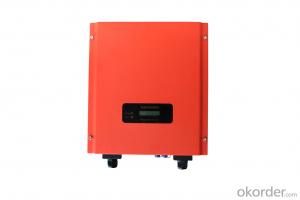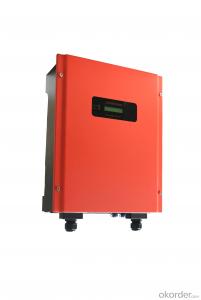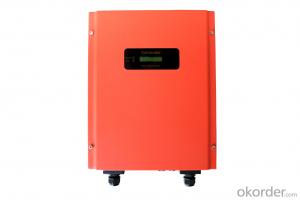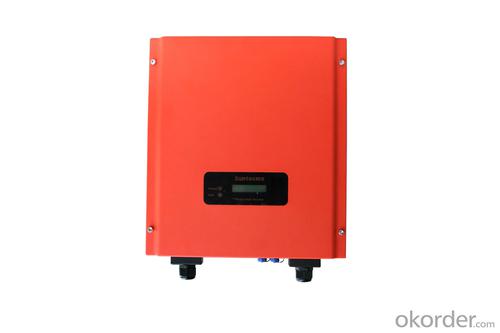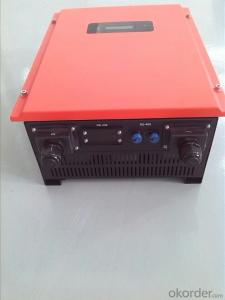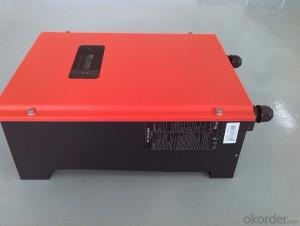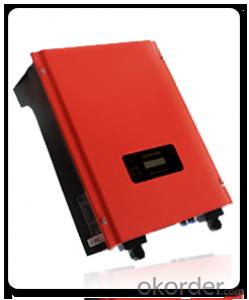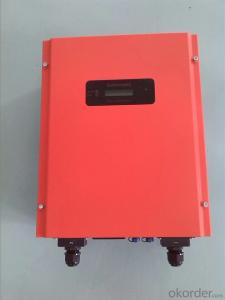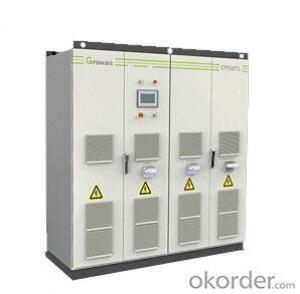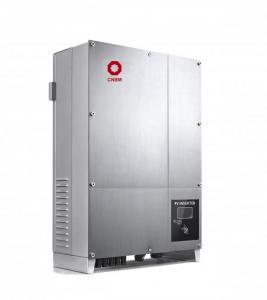PV Inverter Sunteams 1500-3000
- Loading Port:
- China Main Port
- Payment Terms:
- TT OR LC
- Min Order Qty:
- -
- Supply Capability:
- -
OKorder Service Pledge
OKorder Financial Service
You Might Also Like
The Sunteams 1500 ~5000 series isapplicable to various rooftops and small scale photovoltaic grid-connectedpower plants. Their nominal output powers are 1.5 kW, 2 kW, 2.5 kW, 3 kW, 3.6 kW, 4 kW and 5kW respectively.
This series is transformerless and has a wide range of MPPT input voltage. Itsmaximum conversion efficiency and MPPT tracking accuracy reach 97.6 % and 99.5% respectively. The maximum DC voltage reaches 550 V. Its multilingualLCD display facilitates easy operation. It has waterproof direct plug interminals. It has overvoltage, islanding, short circuit, overloading andoverheating protection functions. Its IP65 protection degree will ensure itruns well in various tough environments.
These units are available with or without wirebox.
- Q: Can a solar inverter be used with different types of solar tracking systems?
- Yes, a solar inverter can be used with different types of solar tracking systems. Solar inverters are designed to convert the direct current (DC) produced by solar panels into alternating current (AC) for use in homes or businesses. They are compatible with various solar tracking systems, including single-axis and dual-axis trackers, as long as the voltage and power ratings of the inverter match the requirements of the specific tracking system.
- Q: How long does it take to install a solar inverter?
- The time it takes to install a solar inverter can vary depending on various factors such as the complexity of the installation, the size of the system, and the experience of the installer. On average, it typically takes a few hours to a full day to complete the installation process.
- Q: How does a solar inverter handle variations in grid voltage?
- A solar inverter handles variations in grid voltage by constantly monitoring the voltage level of the grid. When there are fluctuations or variations in the grid voltage, the inverter adjusts its own output voltage accordingly to ensure a stable and consistent supply of electricity from the solar panels. This allows the inverter to efficiently convert the DC power generated by the solar panels into AC power that matches the grid voltage.
- Q: Are there any fire safety concerns associated with solar inverters?
- Yes, there are some fire safety concerns associated with solar inverters. While solar inverters themselves are not typically a fire hazard, there are a few potential risks to consider. Firstly, improper installation of the solar inverter can lead to electrical issues that may cause a fire. It is important to hire a qualified and certified professional to install the inverter, ensuring that all electrical connections are secure and up to code. Secondly, if the solar inverter is located in an area that is prone to high temperatures or excessive heat, there is a risk of overheating. Inverters generate heat as they convert the direct current (DC) from solar panels into alternating current (AC) for use in homes or businesses. If the inverter is not properly ventilated or if it is exposed to extreme heat, it can overheat and potentially start a fire. Additionally, if there is a fault in the inverter or if it is damaged, it can increase the risk of fire. Regular maintenance and inspection of the solar inverter can help identify any potential issues and ensure its safe operation. To mitigate these fire safety concerns, it is crucial to follow proper installation guidelines, regularly inspect and maintain the inverter, and ensure it is located in a well-ventilated area away from excessive heat sources. It is also advisable to have a fire extinguisher nearby and to have a fire safety plan in place in case of emergencies.
- Q: What is the maximum efficiency at partial load for a solar inverter?
- The maximum efficiency at partial load for a solar inverter typically depends on the specific model and design. However, in general, modern solar inverters are designed to have high efficiency even at partial loads. This means that they can still convert a significant portion of the available solar energy into usable electricity, even when the solar panels are not operating at their maximum capacity. The maximum efficiency at partial load can vary, but it is usually in the range of 85% to 95% for most high-quality solar inverters.
- Q: What is the role of a power monitoring feature in a solar inverter?
- The role of a power monitoring feature in a solar inverter is to constantly monitor and measure the amount of power being generated by the solar panels. This feature allows users to track the performance of their solar system, detect any issues or malfunctions, and optimize the energy output for maximum efficiency. It provides real-time data on the power production, enabling users to make informed decisions regarding energy usage and grid integration.
- Q: Can a solar inverter be used with different types of grid connection standards?
- Yes, a solar inverter can be used with different types of grid connection standards. Solar inverters are designed to convert the direct current (DC) produced by solar panels into alternating current (AC) that is compatible with the electrical grid. They are versatile and can be programmed to work with various grid connection standards, such as single-phase or three-phase systems, different voltage levels, and frequency requirements. This allows solar inverters to be used in a wide range of grid configurations, making them adaptable to different regions and grid infrastructure.
- Q: Can a solar inverter provide power during a blackout?
- No, a solar inverter cannot provide power during a blackout. This is because solar inverters are designed to convert the direct current (DC) electricity generated by solar panels into alternating current (AC) electricity for use in homes or businesses. However, during a blackout, the solar panels cannot generate electricity since the grid connection is lost, and therefore the solar inverter cannot provide power.
- Q: How does a solar inverter handle excess power production?
- A solar inverter handles excess power production by converting the surplus electricity generated by the solar panels into AC power, which can then be either used in the household or fed back into the grid for others to use.
- Q: What are the potential risks of fire or explosions from a faulty solar inverter?
- The potential risks of fire or explosions from a faulty solar inverter include electrical malfunctions, overheating, short circuits, and insulation failures. These issues can lead to the accumulation of heat and energy, causing fires or explosions. Additionally, if the faulty inverter fails to properly regulate the flow of electricity, it can damage connected electrical devices or even cause electrocution hazards. Regular maintenance and inspections are crucial to minimize these risks and ensure safe operation of solar inverters.
Send your message to us
PV Inverter Sunteams 1500-3000
- Loading Port:
- China Main Port
- Payment Terms:
- TT OR LC
- Min Order Qty:
- -
- Supply Capability:
- -
OKorder Service Pledge
OKorder Financial Service
Similar products
Hot products
Hot Searches
Related keywords
